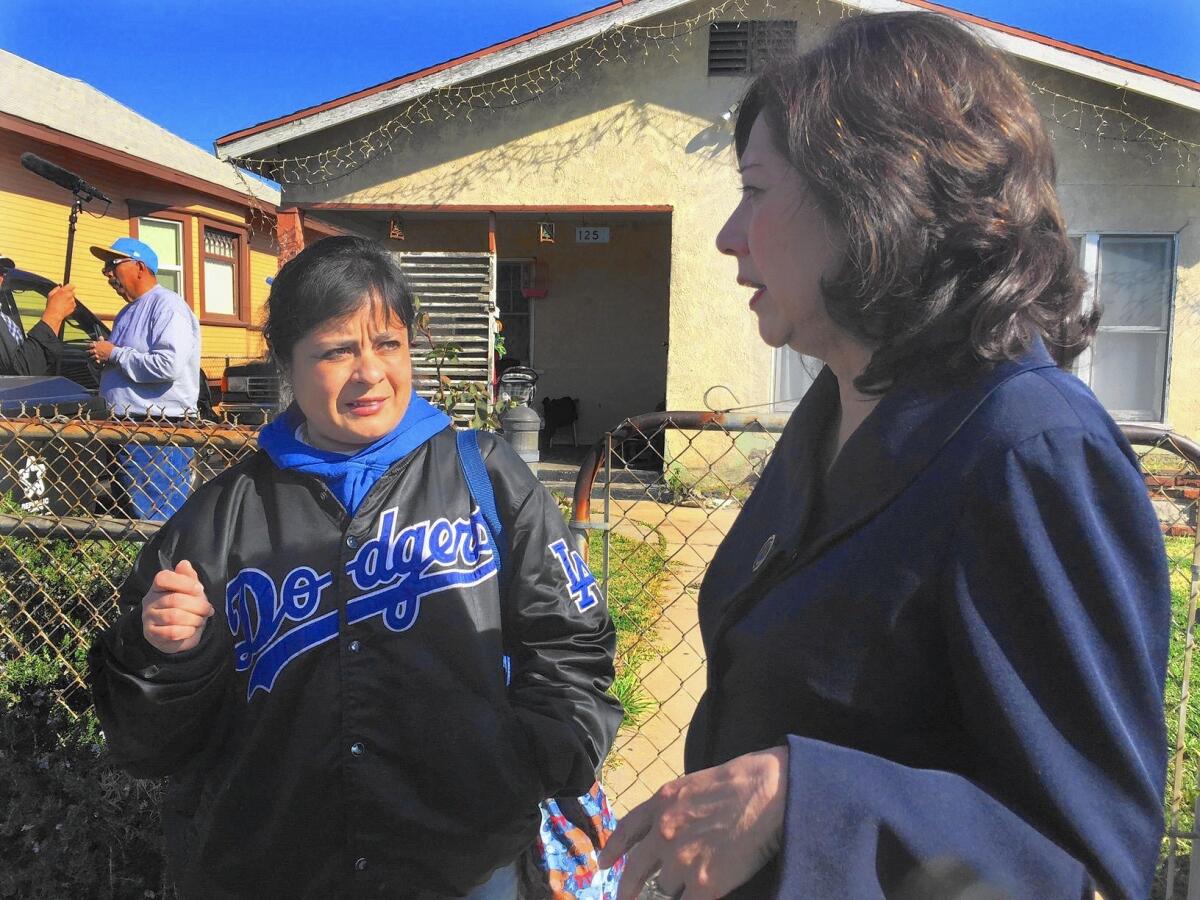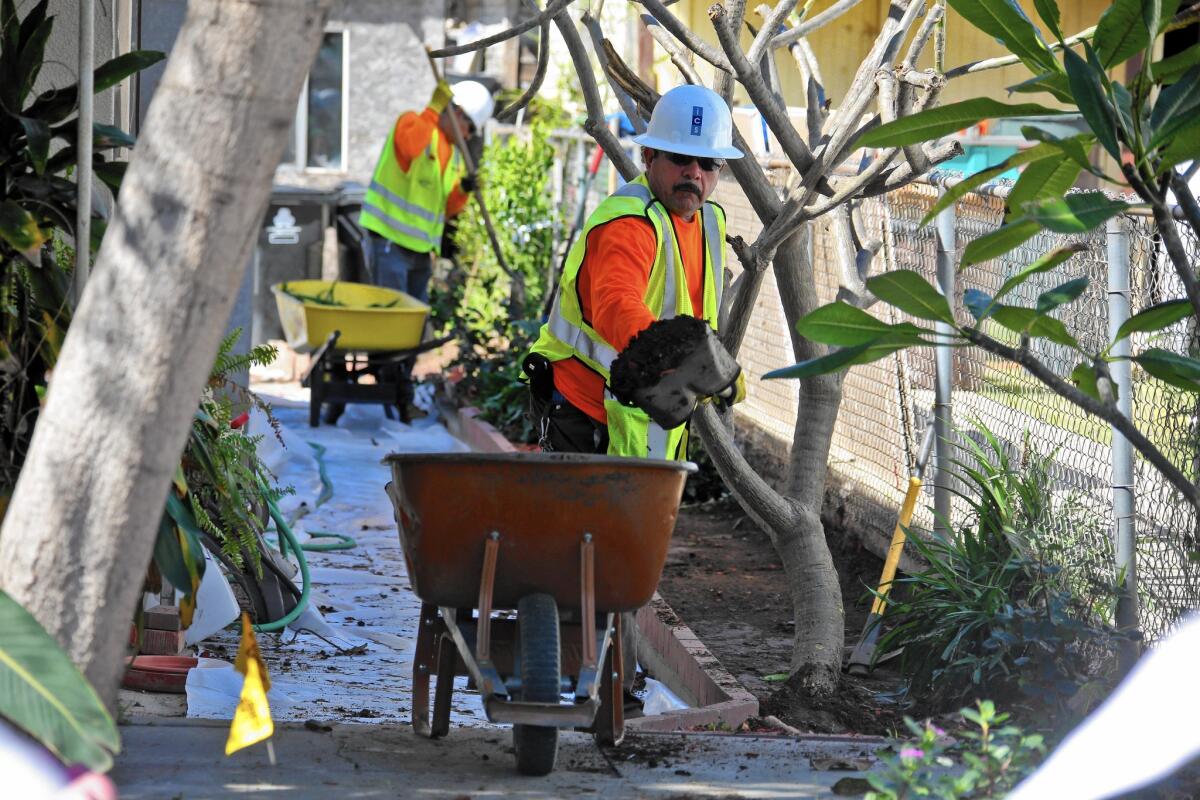Column: Almost a year after Exide shut down its toxic plant, neighbors are trapped in an environmental nightmare

Amelia Vallejo talks to L.A. County Supervisor Hilda Solis about the lead contamination in her yard.
Warmer days are coming soon to the working-class communities east and southeast of downtown Los Angeles, but at many homes, parents won’t let their children play in their yards this spring and possibly into summer.
Terry Cano didn’t hesitate when I asked if her 10-year-old son Edward is allowed to kick a ball or do anything else in the yard of their Boyle Heights home.
“Definitely not,” she said firmly as Edward looked on with a bit of a frown. “And if he does go outside, he is not allowed anywhere near bare dirt.”
The reason is that Cano’s yard is contaminated with toxic lead, which can cause learning disabilities and behavioral problems. And she is not alone.

Unsettled: Exide | Video by Bethany Mollenkof and Spencer Bakalar
In one of the most shocking cases of corporate irresponsibility and government regulatory failure in California history, the Exide battery plant in Vernon sent clouds of toxic substances flying over Commerce, Bell, Huntington Park, East Los Angeles and Boyle Heights for decades.
The number of potentially contaminated homes in the impacted 1.7 mile radius is estimated at 10,000.
And residents of the largely low-incomeLatino communities are wondering why the state is taking so long to come to their rescue, even as Gov. Brown himself visited the site of the Porter Ranch gas leak last year and declared an emergency. Porter Ranch schools were closed as a precautionary measure and residents relocated to safer areas.
“If someone gets a nose bleed in Porter Ranch, they relocate them,” said Cano. “I think it’s criminal, the amount of time they’re taking.”
“They moved mountains” in Porter Ranch, said East L.A. resident Amelia Vallejo, whose youngest son, Michael, 5, has severe developmental disabilities and is hard of hearing. “We’ve been here for years and look at our kids…they’re damaged for life.
“Why don’t they come here and raise a commotion? Is it because we’re poor? Is it because we don’t speak out? Is it because we’re not white?”
Porter Ranch residents, to be fair, have their own legitimate fears and anger over the state’s regulatory failures.
But it’s not hard to understand why Vallejo and others see the response in their communities as insult on top of injury. Exide operated on a temporary permit for 30 years despite outdated pollution controls, and the state Department of Toxic Substances Control knew for years that the company was polluting air, soil and water but failed to put a stop to it.
The plant was tagged with dozens of air-quality and hazardous-waste violations over that time, but kept spewing an airborne cocktail that included arsenic. Air quality officials have said the arsenic posed an increased risk of cancer to roughly 100,000 residents.
Finally, under state pressure and threat of federal criminal charges, Exide officials slithered out from under prosecution in March last year by agreeing to shut the plant and pay $50 million to clean up the site and surrounding communities.
But almost a year later, fewer than 200 properties have been cleaned, and the Brown administration has so far budgeted just $8.5 million for the Exide cleanup.
At this rate, homeowners will wait years for help.
L.A. County Supervisor Hilda Solis, who has tapped county funds and joined with several legislators in calling for a bigger state commitment, says it would cost about $45 million to clean the 1,000 most contaminated properties and another $25 million to test all 10,000 homes.
“I’m hoping the efforts to get the governor and the state more involved will result in more immediate cleanup, assessment and remediation,” Solis said Thursday while meeting with area residents. “People still live here and they’ll continue to live here because they have nowhere to go.”
So where’s Gov. Brown on this?
When I asked on Friday, his office referred me to the Department of Toxic Substances Control and director Barbara Lee.
She told me the governor has called the Exide cleanup a priority, and provided $7 million last year to supplement $9 million from Exide. She said a team of 50 people has been cleaning the most contaminated properties first while testing other properties and producing a plan that lays out how long and costly a total cleanup will be.

Work crews remove topsoil from yards in the 1200 block of South Indiana Street in Boyle Heights.
The goal is to extract as much money as possible from Exide, which is in bankruptcy, to cover state costs. After I spoke to Lee, an email from a Brown press secretary extolled the progress made by Toxic Substances Control and said “we’ll continue to work with…the Legislature and local and federal government to hold Exide accountable, get more funding and see this through.”
The community might have a little more faith if the governor himself would personally express those commitments, and if he made time to travel to East L.A. just as he made time to fly to Paris, where he took bows for his environmental record.
The people of these communities are living through an environmental nightmare, and it took seven months after contamination was first confirmed for the state to begin taking soil samples late last year.
You can’t talk to anyone without hearing stories about friends and relatives who died young, or are suffering through life-altering illness and disease. Many people live with fears of physical and intellectual limitations for their children, down the road. And residents are afraid to eat fruits and vegetables from their own backyard gardens.
Bertha Velasquez, a Solis field deputy, got a high lead reading in her Boyle Heights yard. She has a daughter who is deaf, and two more females on her block are also deaf.
Hugo Lujan, of East Yard Communities for Environmental Justice, said it took months of pressure before some schools and parks were tested. The East L.A. resident requested a soil test at his home last October and is still awaiting a response.
Amelia Vallejo says her yard was tested in December and showed a frightening lead reading of 1,471 parts per million, well above safe levels.
“I thought my world was going to fall apart when they gave me the results,” said Vallejo, whose six childeren—all of whom have asthma--have played in the yard all their lives.
Her cleanup is scheduled for March, Vallejo said, but she thinks she would have had to wait many more months if she didn’t go to Solis’ office for help.
Terry Cano said her yard was tested last April and she didn’t learn until October that she had readings as high as 1550 parts per million. Her soil still has not been cleaned up while her attorney looks into a dispute over precisely what needs to be done.
“My parents are both gone and both were on oxygen tanks. My brother was diagnosed with terminal cancer. I’m 43 and I’ve had a stroke and mini-strokes after that,” said Cano, who has lived in the area her entire life.
Like others, she’ll have to keep waiting for help and peace of mind, not knowing if that will take weeks, months, or years.
Twitter: @LATStevelopez
ALSO
Documents ex-L.A. councilman sought to destroy are made public by successor
Couple who planted drugs in PTA president’s car must pay $5.7 million, jury decides
Winter gone? Temperatures nearing 90 degrees in Southern California with gusty winds
More to Read
Sign up for Essential California
The most important California stories and recommendations in your inbox every morning.
You may occasionally receive promotional content from the Los Angeles Times.











